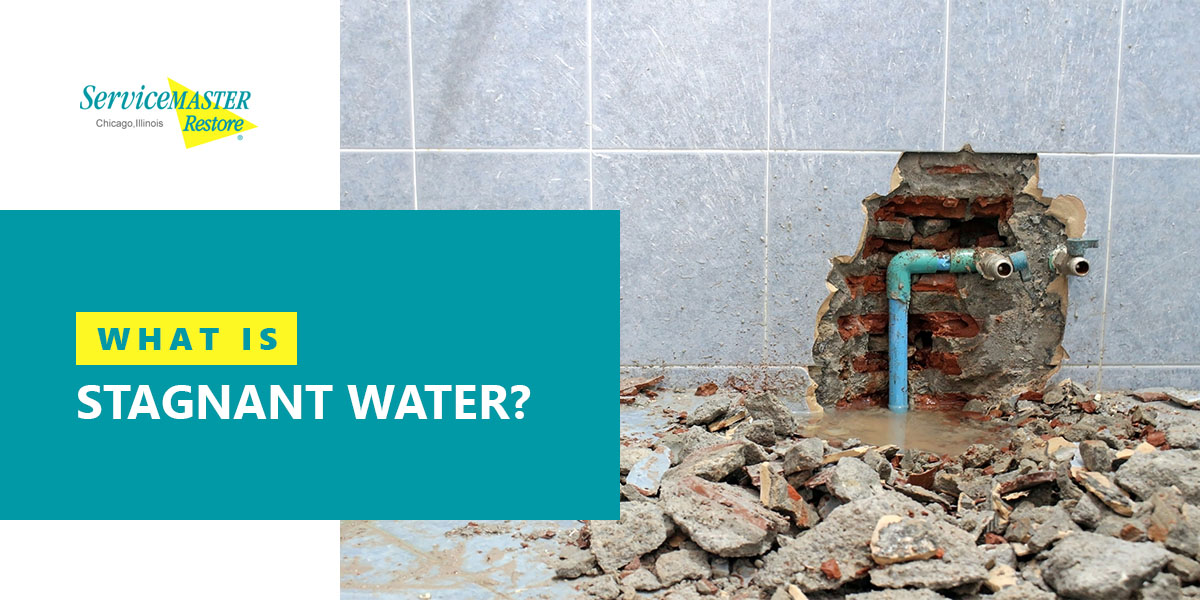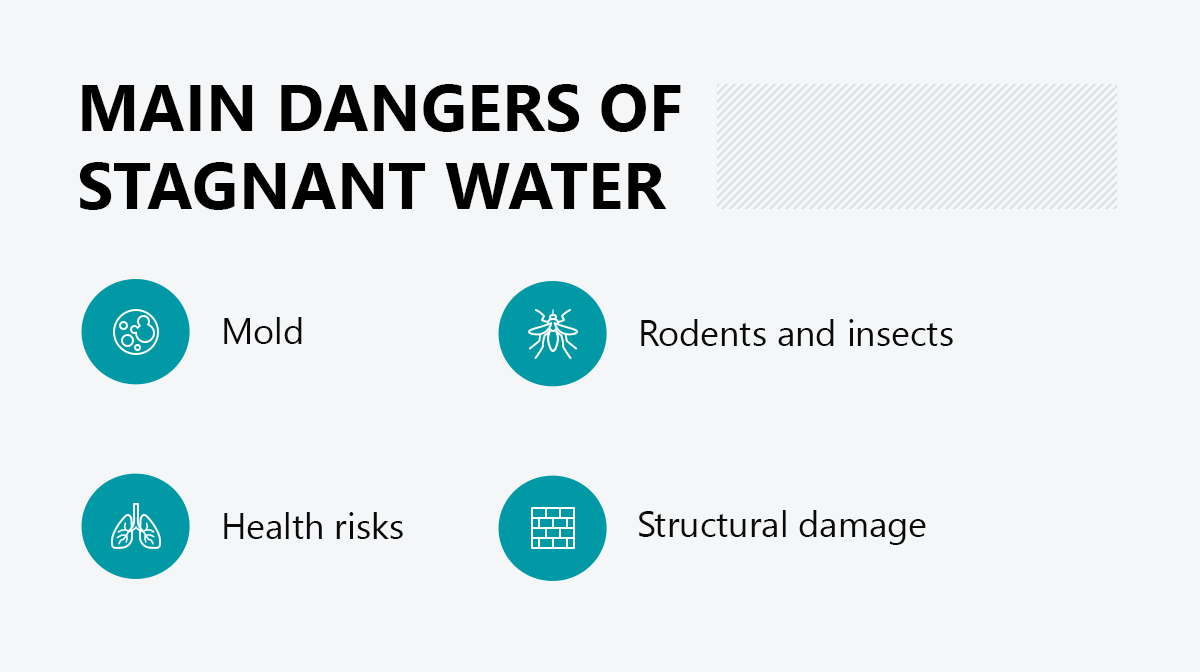
Water — we need it to live, but it can also bring destruction. Floods and heavy rains are two examples of water’s potential for causing damage. Combine that with water’s ability to freeze and expand, and you might be looking at significant risk to your home.
Your house was built to last. But water coming in at the wrong time can damage your home, shortening its life span and devaluing your financial investment. But while surging floods and blustering storms are obvious dangers involving water, there’s another watery threat you should know about — stagnant water.
What Causes Stagnant Water?
Stagnant water, or standing water, is a still layer of water in an unwanted location. Despite the various causes, all types of water stagnation have one thing in common. Any time stagnant water is present, it’s because water has stopped flowing or moving when it otherwise would be. The standing water can also be present in a location where there should be no water.
Stagnant water is usually outside your control, sometimes without you even knowing it’s there. Most bodies of water become stagnant when they have not moved in 24 hours or so. Various health risks — which you can read about in a later section — can start building up in the water within that timeframe.
Here are some common causes of stagnant water in buildings:
- Frozen pipes: When pipes freeze, water expands, and unfrozen water is less able to travel freely through them. This leads to a buildup of water pressure, which can result in your pipes bursting. A burst pipe will let water out, leading to standing water nearby.
- Natural disasters: Floods, hurricanes and severe snowmelt can cause water to get into your house. Many people’s basements fill with a few inches or a few feet of water during these events, depending on the severity. If left unchecked, this water will quickly become stagnant.
- Cracked foundation: Even when the weather is moderate, a cracked foundation will let moisture into your home. As more water enters a space, the water can build up and become stagnant.
- Leaks: Leaks throughout your house from pipes or fixtures can contribute to standing water in your walls, floors and ceilings.
Signs You Have Stagnant Water
Sometimes, stagnant water can be difficult to notice right away. Other times, it’s easy to realize that you’re dealing with stagnant water. You need to keep your eyes — and nose — open for signs of stagnant water in your home.
You might be dealing with stagnant water if:
- You can see a clear body of still water in your home where it shouldn’t be.
- The body of water has a film on the top.
- You see a strange tint in the water, showing you that other organisms or materials have made the water their home.
Then, see if you notice that the water is giving off a strange odor. This can include a sulfuric smell like rotten eggs, which will let you know immediately that something is wrong. If you cannot see any visual signs of stagnant water but can smell something like sulfur in the air, there’s a good chance you’re dealing with standing water somewhere in your home.
Is Stagnant Water Dangerous?
Yes, stagnant water is dangerous. Here are some of the main dangers of stagnant water:
- Mold: stagnant water can saturate your home’s walls and floors. Even if the standing water goes away, the moisture in your home can stay and contribute to mold growth. This is an even higher risk if the standing water includes sewage or other contaminants.
- Rodents and insects: Rodents and insects need water to live and thrive, too. Standing water provides the perfect body of water for their needs. Rodents may drink from your pool of standing water, while insects like mosquitoes can use standing water to lay their eggs. You want to avoid this since mosquitoes are the primary carrier of the Zika virus.
- Health risks: Standing water can put you and your family close to other health risks aside from the Zika virus. These include malaria, fungus and rotavirus. Symptoms can range from slow-building to oppressive.
- Structural damage: Standing water will also impact your home’s structural integrity. Water damage can cause wood, drywall and concrete to deteriorate. You could face costly repairs or dangerous collapses under the worst circumstances.

Can Stagnant Water Make You Sick?
Stagnant water can contribute to several illnesses, as you read above. Besides drawing rodents and insects to your home, stagnant water is a breeding ground for bacteria. Many varieties of bacteria are hazardous to animals and humans alike. Drinking stagnant water, or even touching it, could make someone fall ill.
Mold is also a major contributor to health conditions. Mold spores spread rapidly. Over time, you could begin smelling the musty scent of mold throughout your home. In some cases, this can cause the residents of your home to become sick from the mold’s presence.
How to Clean Stagnant Water
Cleaning stagnant water is an involved task, but it’s crucial to your and your family’s health and the well-being of your home. Here’s how you can clean stagnant water:
- Remove the standing water: The first step is to remove the standing water from your home. Use a pump or bucket for deeper pools. You may use a rag to soak up shallow layers of stagnant water. Make sure to protect yourself accordingly.
- Remove any damaged materials: If the water seeped into your walls, studs, ceilings or floorboards, you’ll have to remove those damaged materials from the premises. Letting them stay could keep moisture in your home, which contributes to mold growth.
- Dry out your home: Next, you’ll need to dry out your home as much as possible. High-powered fans and dehumidifiers are both must-have devices for this task.
- Repair the source of the stagnant water: To stop the standing water from returning, you’ll need to repair the source of the issue. This may be a broken pipe, cracked sealant around your bathtub or a breach in your home’s foundation.
- Clean and disinfect the location: Be sure to clean the areas that experienced stagnant water. This will aid in keeping mold and bacteria from surviving and spreading.
- Restore your home: The final step is to remediate your home. This may include replacing drywall, laying down a new carpet, repainting walls or installing new cabinets.
Contact ServiceMaster of Lincoln Park for Water Damage Restoration Services
At ServiceMaster of Lincoln Park, we understand the stresses of discovering standing water in your home. That’s why we’re here to help, night or day. Our goal is to help your home recover from water damage. We promise to do it right or do it over — guaranteed.
Contact us today to take the next step toward restoring your home after suffering from stagnant water. Our professional team is ready to help!


